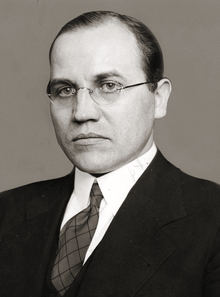Kazys Škirpa
Kazys Škirpa (18 February 1895 – 18 August 1979) was a Lithuanian military officer and diplomat. He is best known as the founder of the Lithuanian Activist Front (LAF) and his involvement in the attempt to establish Lithuanian independence in June 1941.
Kazys Škirpa | |
|---|---|
 | |
| Born | 18 February 1895 |
| Died | 18 August 1979 (aged 84) |
| Burial place | Petrašiūnai Cemetery (reburied in 1995) |
| Nationality | Lithuanian |
| Alma mater | Institute of Technology in Zurich Higher Military School in Kaunas Royal Military Academy (Belgium) |
| Occupation | Military officer, diplomat |
| Employer | Lithuanian Army Government of Lithuania University of Dublin Library of Congress |
| Known for | Leader of the Lithuanian Activist Front |
Army career
During World War I, he was mobilized into the Imperial Russian Army and attempted to form Lithuanian detachments in Petrograd. After Lithuania declared independence in 1918, he returned and volunteered during the Lithuanian Wars of Independence. In 1920, as a member of the Lithuanian Peasant Popular Union, he was elected to the Constituent Assembly of Lithuania. After that he decided to pursue a military education in Institute of Technology in Zurich, Higher Military School in Kaunas, and Royal Military Academy (Belgium).[1] Upon graduation in 1925, he worked as chief of the General Staff, but was forced to resign after the 1926 Lithuanian coup d'état, because he was actively refusing it and was trying to gather military force to protect the government.
Political career
Later he served as a Lithuanian representative to Germany (1927–1930), League of Nations (1937), Poland (1938), and again Germany (1938–1941). After Soviet Union occupied Lithuania in 1940, Škirpa fled to Germany and formed the Lithuanian Activist Front (LAF), a short-lived resistance organisation whose goal was to liberate Lithuania and re-establish its independence by working with the Nazis.[2] According to Victims of Communism Memorial Foundation, he was a primary source of the secret part of the Molotov–Ribbentrop Pact which he sent to the Latvian foreign minister Vilhelms Munters in 1939.[3] When Nazis invaded the Soviet Union in June 1941, many members of LAF cooperated with the Nazis and killed thousands of Lithuanian Jews (see the Holocaust in Lithuania).[2] He was named prime minister in the Provisional Government of Lithuania; however, the Germans placed him under house arrest and did not allow him to leave for Lithuania.[4] He moved from Berlin to southern Germany and was allowed a short visit to Kaunas only in October 1943.[1] In June 1944, he was arrested for sending a memorandum to the Nazi officials asking to replace German authorities in Lithuania with a Lithuanian government. He was first imprisoned in a concentration camp in Bad Godesberg and in February 1945 was moved to Jezeří Castle.[1]
Later life
After the war, he went to Paris and from there to Dublin, where he taught Russian at the University of Dublin.[1] In 1949, he emigrated to the United States. He worked at the Library of Congress.[1] In 1975, his memoir book about the 1941 independence movement was published. Originally interred in Washington, D.C., his remains were returned to Kaunas in June 1995, where he was reburied in Petrašiūnai Cemetery.[1] The state-sponsored ceremony included honor guards at Vytautas the Great War Museum and speeches by then Lithuanian Prime minister Adolfas Šleževičius and Defense Minister Linas Linkevičius.[5]
Alleged antisemitism and street names controversy
In 2019, due to Škirpa's connection with the Lithuanian Activist Front a national controversy began when Vilnius' left-wing mayor changed the name of a street from Škirpa to "Trispalvės" ("Tricolour", a reference to the flag of Lithuania).[6][7] The name change was opposed by several Lithuanian center-right and right-wing politicians as well as the government-funded Genocide and Resistance Research Centre of Lithuania (LGGRTC)[8] which itself had been accused of antisemitism for not mentioning the Holocaust in Lithuania at its "Museum of Genocide Victims" in Vilnius until 2011 and in 2018 renaming the museum the "Museum of Occupations and Freedom Fights".[9][10]
References
- Ignatavičius, Stasys; Tamulaitis, Gintautas (20 February 2015). "Pirmasis Lietuvos kariuomenės savanoris" (PDF). Tremtinys (in Lithuanian). 7 (1125): 5. ISSN 2029-509X.
- Timothy Snyder - Bloodlands: Europe Between Hitler and Stalin, ch.6-Final Solution. 2012. ISBN 978-0-465-0-3147-4
- "Chekhov's Gun: The Molotov-Ribbentrop Pact in the Baltics". Victims of Communism Memorial Foundation. Retrieved 2019-05-13.
- Burauskaitė, Teresė Birutė (2016-01-05). "Kazio Škirpos veiklą Antrojo pasaulinio karo metais" (PDF). Genocide and Resistance Research Centre of Lithuania. Retrieved 2016-10-22.
- Šepetytė, Danutė (23 February 2020). "Buvo Kazys Škirpa antisemitas ar nebuvo" (in Lithuanian). Respublika. Retrieved 30 May 2020.
- "Sostinės taryba apsisprendė: Škirpos alėją pervadina į Trispalvės". lrt.lt (in Lithuanian). 2019-07-24. Retrieved 2019-07-27.
- Katz, Jason. "Surmounting Lithuania's Holocaust past". The Washington Times. Retrieved 2019-07-27.
- Kulinauskas, Andrius (2015-12-18). "Documents Which Argue for Ethnic Cleansing (by Kazys Škirpa, Stasys Raštikis, Stasys Lozoraitis and Petras Klimas in 1940-1941 and by Birutė Teresė Burauskaitė in 2015)".
- Norland, Rod (March 30, 2018). "Where The Genocide Museum Is (Mostly) Mum on the Fate of Jews". The New York Times.
- Andrukaitytė, Milena (19 April 2018). "Genocido aukų muziejus pervadintas į Okupacijų ir laisvės kovų muziejų" (in Lithuanian). 15 min. Retrieved 28 April 2018.
Further reading
- Simas Sužiedėlis, ed. (1970–1978). "Škirpa, Kazys". Encyclopedia Lituanica. V. Boston, Massachusetts: Juozas Kapočius. p. 206. LCC 74-114275.
- "Kazys Škirpa" (in Lithuanian). Seimas. 2006-02-22. Retrieved 2008-03-29.